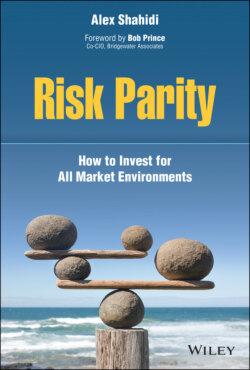Читать книгу Risk Parity - Alex Shahidi - Страница 19
A Smoother Path
ОглавлениеStarting from a high‐level conceptual framework, a smoother path can be attained by investing across a wide range of return streams that are different from one another. By different, I mean that while they all go up over time, their ups and downs generally do not coincide. As a result, a total portfolio that is made up of these fluctuating constituents should exhibit less variability over time than any single one of them. This is the core insight of Modern Portfolio Theory, which posits that a portfolio made up of diverse components can exhibit less risk for a given level of return than a less diversified mix. The bold line in Figure 1.1 illustrates the conceptual idea of a smoother path – one that takes less risk to earn a similar return.
If we strive to grow the portfolio from Point A to Point B, allocating across multiple assets that all end at Point B but proceed through different paths yields a less bumpy ride for the total portfolio. A good metaphor for this framework is an automobile engine. The engine is made up of a diverse mix of parts: pistons, cylinders, chains, spark plugs, crankshafts, valves, and so on. Each component is necessary and functions very differently from the other parts. Each has a pre‐defined role to ensure smooth operation for the whole. If you were to view the inside of a properly designed and constructed engine block, you would observe chaos as various pieces would be operating in different directions and at a varying pace. Yet, the finely tuned machine purrs along smoothly when viewed from the outside. I believe we can build portfolios using a similar construct.
Figure 1.1 Building a Smoother Path
Ray famously referred to this investment approach as “the holy grail.” If investors are able to identify 10 good, uncorrelated investments and split their portfolio roughly equally among them, then they could enjoy attractive returns with low risk. The concept is supported by the notion that when one investment is doing well, another may be underperforming, and they can balance each other out to yield a return closer to the average of the two. Including more uncorrelated return streams would drastically reduce the total risk of the portfolio.
The simple math is extremely compelling. A portfolio of a single risky asset with an 8% expected return and 15% volatility (standard deviation) has about a 30% chance of losing money in a single year. If we have five assets that offer the same returns and risk but are uncorrelated with one another and we allocate equally across the five, then the risk of the total portfolio is less than half of the one‐asset portfolio, and the odds of losing money in a single year significantly lower. Risk decreases even further as we go from five uncorrelated assets to 10, although there are diminishing returns to diversification beyond a certain point. The math is provided in Table 1.1.
Table 1.1 Portfolios of High Returning, Uncorrelated Investments
| 1‐AssetPortfolio | 5‐AssetPortfolio | 10‐Asset Portfolio | |
|---|---|---|---|
| Return | 8% | 8% | 8% |
| Risk (volatility) | 15% | 7% | 5% |
| Odds of losing money in one year | 30% | 12% | 5% |
Same Return and Less Risk –>
As Figure 1.1 and Table 1.1 illustrate, a similar return can be mathematically achieved with less risk if lowly correlated, high‐returning assets are utilized to construct a portfolio.
Finding 5 to 10 uncorrelated investments with attractive returns can be difficult, particularly in liquid public markets (which is the scope of this study). However, the point of this exercise is to demonstrate the power of diversification and the simple approach that we follow to construct a portfolio with expected returns competitive with equities with less risk. Clearly, implementing the conceptual framework can be challenging, which is why I have devoted an entire book to the subject. We now dive one step deeper into the risk parity framework by describing where returns come from, defining risk, and explaining why a traditional portfolio is poorly balanced.
